
Three generations of Wilson men like to bake bread and
Zula Wilson Cathey related, "We knew the day Grandpa Wilson baked bread and we
always stopped for fresh bread and honey. He had bees, beehives, and plenty of
honey." Her father, Joseph Leonard Wilson, baked good bread as does her brother,
former county assessor, Darrell Wilson.
The Wilson farm, Wayne and Zula
Wilson Cathey and Darrell and Gwen Wilson, did not get registered as a century
farm although it qualified.
Lewis Dunbar Wilson came to the Upper Snake
River Valley in 1885 and was one of the five original people to homestead west
of the river near Blackfoot.
Discussing her grandfather, Zulu remarked,
"My sister and I gave grandpa a mustache cup so his mustache wouldn't get in the
cup when he drank from it. His mustache was his pride and joy and he would stand
in front of the mirror and comb and trim it to make sure it was always even.
"My grandfather was a very good person and loved to associate with people.
He was a stern person with his family and taught them to be honest. If he gave
you a job to do, he expected you to do it and in a way he would approve of. You
played after the work was done.
"He liked children and loved to tell us
stories. He world howl like a coyote to tease us.
"Grandpa told me when
he came to this area they cleared the land the hard way. They would fell a big
tree and hook a horse on each end and then drag the tree through the sagebrush
to break if off and then burn it.
"Grandpa would give us kids a nickel
to walk to the store and buy him some square cakes of chewing tobacco called
'Horseshoe Tobacco.' We would walk to the Oborne store (in the tall poplar trees
where Simplot Fertilizer is presently located) and Mr. Oborne would give us
extra penny candy and visit with us and tell us stories."
She told about
Mr. Wilson going to check on the water he had put on a patch of potatoes and
came back to say, "Well, we don't have to worry about watering that potato patch
anymore. The river came down and washed it all out." That is where the branch of
the river is down by Darrell's house.

Lewis Dunbar Wilson's Walking Plow
When he came to Bingham County he homesteaded two farms and
built two sturdy identical log houses on each homesite. They both had shade
trees, fruit trees, gardens, and berry bushes.
Lewis Dunbar Wilson Jr.
was born September 21, 1840, at Nauvoo, Illinois. He walked across the plains
with his father. He married Catharine Wiggins in 1862 and they lived in Ogden,
Utah. There they established the first hardware store and lumberyard.
A
polygamist, he took his second wife, Eliza Ellen Hunt, in 1873. The Edmunds
Anti-Polygamy Law made life difficult for the men who did not desert their
wives. If they stayed with the whole family they were constantly harassed by the
U. S. marshals.
In 1887 he was arrested and given his choice to give up
his second wife or go to prison. He felt he could not desert her or the children
and went to prison. He was sentenced to six months hard labor. He served three
months and was released. Shortly after he returned home he was arrested again.
This time he was tried and sentenced to serve two years at the federal prison in
Sioux Falls, South Dakota. He was released after serving eighteen months. Then
he was given visitation rights with the family. He could only visit his second
family.
Tom Williams, in his book. Miracle of the Desert, reported, "The
first shipper of potatoes in Bingham County was L. D. Wilson. According to his
son Joe Wilson and his daughter Mrs. John I. Watson (Elveretta), Mr. Wilson
shipped the first car of potatoes in the fall of 1889. So far as the writer has
been able to ascertain, these were the first potatoes shipped in Idaho."
His family relates this story: "One year after growing a large crop of
potatoes he could not find a sale for them. So he put into effect his ingenuity
and dauntless ambition, boarding a train for New York City. There he went into
one of the large hotels and asked the management that his gift of Idaho rural
potatoes be baked and served to the hotel guests for dinner. During the meal he
was presented to the dinning room and introduced as 'Wilson, Potato King.' who
had given potatoes that they were eating as a compliment. This title he carried
until his death. He sold his entire potato crop at a good price. He shipped them
directly to New York City.
Lewis Dunbar Wilson Died at age eighty-one on
January 22, 1922.
Wayne and Zulu Wilson Cathey have sixty-five acres of
the original homestead and live in one of the original homes Lewis Dunbar Wilson
built. They now lease the ground to someone else to farm as they have been
retired for six years.
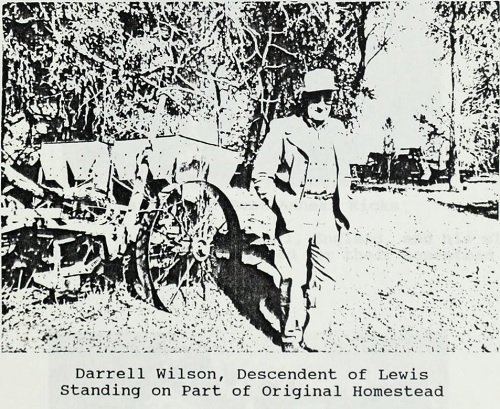
Darrell Wilson, Descendent of Lewis
Standing on Part of Original Homestead
George Knodle is the fourth generation of Charles and Emma Wicks and owns the original homestead of 160 acres. He and his wife, Merleen, are looking forward to remodelling and moving into the old ranch home.
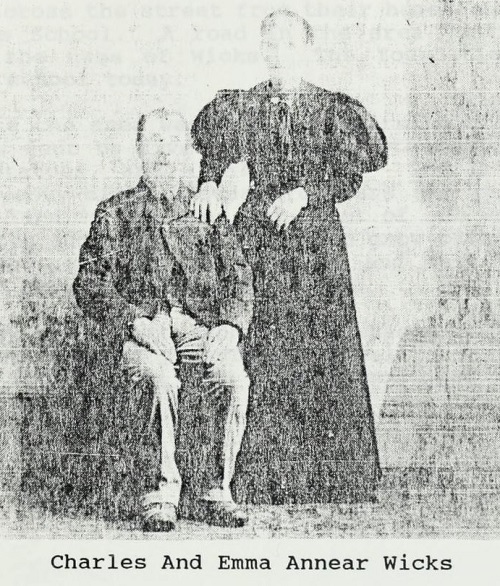
Charles And Emma Annear Wicks
Charles Wicks came from Cornwall, England, and his wife, Emma Annear, was from Dover, Md. They filed for their homestead in 1885.

The Wicks homestead
A school across the street
from their homestead was named for them, the Wicks School. A road in the area
just off Rich Lane still retains the name of Wicks. The foundation is all that
remains of the school today.
At one time the area was very good farming
ground and George said grain grew four to five feet high. Other crops on the
farm were beets, potatoes, and alfalfa seed. George has a receipt showing that
twenty-eight thousand dollars was paid for alfalfa seed. Now the land in the
area has a lot of sub water coming up. George has cattle and this year tried to
grow oats but it was not a success. The corn grew much better and next year they
will probably try to grow more corn.
The old hay wagon with iron rimmed
wheels rests by the ranch and one of George's great grandfather Powell's freight
wagons was sitting in the front yard. The wagons were used to haul freight from
Blackfoot to Challis.
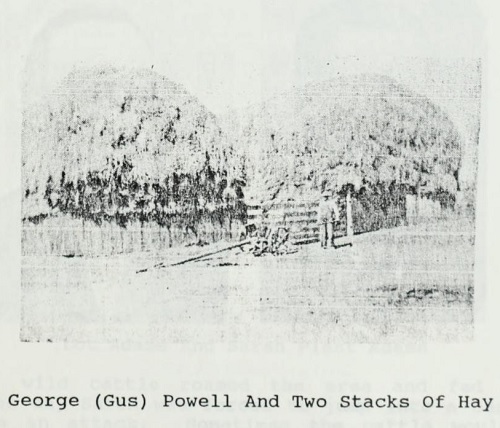
George (Gus) Powell And Two Stacks Of Hay
George remarked, "This ranch house means a lot to me. My mom,
Emma Powell Knodle, was born here and my sister, Francis, was born in the same
bedroom." Francis now resides in Dallas, Texas.
Emma Annear Wicks was
born July 4, 1835, and died January 30, 1908. Charles Wicks was born January 21,
1843, and died January 14, 1926. They are both buried in the Grove City
Cemetery.
Wild Cows, sagebrush roads, and
living in a dugout are some of the obstacles Lot and Sarah Plant Adams overcame
when they homesteaded 160 acres in Riverside, Idaho, in 1885.
Lot was
born in Rounds, England, November 5, 1850, and came to the United States when he
was fifteen years old. Sara Plant arrived in Richmond, Utah, from England when
she was five years old. She and Lot were married February 17, 1881. They had
four children born to them before they came to Idaho and five more after getting
here.
Their son, Maurice, is still living in Riverside and on his
birthday, November 30, 1990, will be ninety-two.

Lot Adams And Sarah Plant Adams
Fierce, wild cattle roamed the area and fed where
they pleased. One day Sarah was forced to jump into a canal to save herself from
an attack. Sometimes the cattle would come and destroy a whole wheat field.
When the LaRocque family left the area they let the lot Adams family live in
their dugout. When they returned the Adams family had their own land and a home
hewn from timber which grew along the river.
Lot helped to build the
Wearyrick Ditch. This canal was built the hard way with a pick, shovel, teams of
horses, and slip scrapers. He also helped build the Danskin Canal. The water was
taken out where it would be the easiest so the Wearyrick Canal was taken out in
a natural channel of the Snake River where the water ran except for a low water
season. Lot's son, Maurice, was secretary of the Wearyrick Canal for sixty-five
years Adams has taken the job for the last two years.
Maurice's son,
Willard, and his wife, Bette Jane, purchased forty-one acres. Bill, as some
folks know him, said, "I am proud to own a portion of the land and live in the
home that was part of the home built by my grandfather, Lot Adams."

One of Three Homes Lot Built
Nels Anderson Just was a young pioneer with a natural gift for the love of the land
and water. He engaged in various pursuits such as mining, stockraising,
ranching, banking, and milling. But the thing nearest his heart was irrigation.
He was one of the chief promoters of the Idaho Canal System.
Nels was
born in Denmark, April 17, 1847, and arrived in Utah while still a young man. He
had a wagon and two yoke of oxen and went into the freighting business. During
the summer of 1870 he hauled vegetables from Boise to the mining towns in
Montana. That was quite a distance to keep vegetables fresh.
One night
while he was camped near the present townsite of Firth, Idaho, his oxen strayed.
When daylight arrived he followed their tracks and they led him to the Blackfoot
River and a beautiful valley that he later homesteaded with his new bride, Emma
Thompson Bennett.
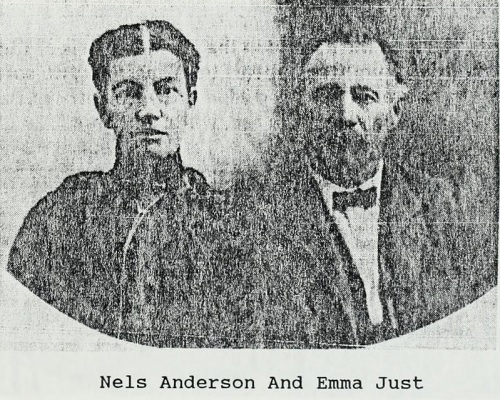
Nels Anderson and Emma Just
Emma was born in England, January 21, 1850. She was twenty years old and had a
year old son when she married Nels. Her former husband had deserted her four
months before the baby arrived. They were married November 9, 1870, in Malad,
Idaho.
They returned to the beautiful site Nels had discovered and spent
their first winter there in a dugout with no windows and a buffalo robe for a
door. It was in this "cellar house" a year later that their first child, James,
was born.
They grew a garden and irrigated it with a bucket. He fished
and hunted. To bring in extra money Nels would bring Emma washing to do from
Eagle Rock (Idaho Falls) eighteen miles away. Some of the time they had a beef
contract and supplied the meat to Fort Hall for the soldiers.
By filing
a homestead, a desert claim, and a timber culture a continuous strip of land was
secured for future generations. As the older boys were able to buy land the Just
farm became a solid block of land more than a mile wide and two miles long along
the Blackfoot River.
Nels worked as a promoter and contractor for the
Idaho Canal and his sons followed the slip scraper that created the first big
canal system in this part of Idaho. This canal flows from just south of Idaho
Falls for over one hundred miles until it discharges into the Blackfoot River.
There was plenty of water in the river but getting it to the land would
be a gigantic task. Bluffs of rock lay in the path of the ditch and the white
volcanic ash was not very good at holding water.
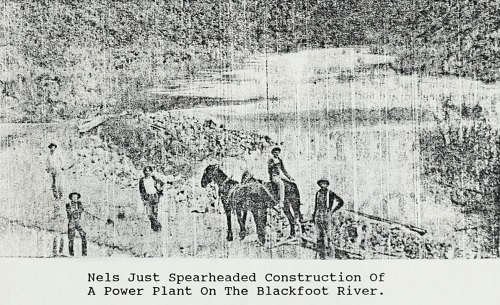
Nels Just Spearheaded Construction Of A Power Plant On The Blackfoot River.
Nels died March 28, 1912, at the age of sixty-five. Emma died November 8, 1923, at
the age of seventy-three. They are buried on part of the old homestead that was
set aside for a cemetery.
Currently the Reid farm grows hay, grain, and
potatoes. They have extensive livestock.
Robert E. Reid is farming sixty
acres. He said, "When I was eight or ten we used horses and now its modern
machinery. We have come a long way! One man can do today what five or six used
to do. Production has doubled because we have better seed variety."
Wallace Reid compared his work to his ancestors and said everything is
mechanized. "Our irrigation is by sprinkler compared to what Nels had to do to
get water to his alfalfa. We have seen a lot of changes!" He and Marlene farm
sixty acres.
Paul E. Reid said, "It would be interesting to see Nels
operating a back hoe. We clean ditches in a day and to get the water to ground
that took Nels years with picks and shovels by hand and horses." He remarked
that he looks at the obsolete one row potato digger or the beet harvester and
compares them to the machinery today. He farms one hundred and sixty acres.
Fred Reid enjoys working with the cattle and is looking forward to the fall
round-up that occurs each year. They go out and bring the cattle in from the
hills. He said, "We hay all the time. In the summer we haul it in and in the
winter we haul it out, all for the cattle."

Grain Goes Into The Truck And The Rest Goes Into The Straw Stack.
Douglas Reid felt great strides have been made since Nels and Emma homesteaded and remarked as to how they had endured so many hardships that it is hard to imagine all that has happened since they first arrived. Fred and Douglas farm two hundred and ten acres together.
John Henry Stander
was born October 10, 1863, in Brigham City Utah. He herded sheep on the hills
around the city at the age of seven and at an early age was employed by the
railroad working on the rails being laid into Montana. He saved his money and
bought a team of horses and a wagon. He left his home and drove the team to
Idaho in 1885. He was one of the first settlers of the Thomas area and
homesteaded a timber claim of 160 acres of land that was thickly covered with
sagebrush. He worked hard to clear the land and build a log cabin. He helped
make some of the first irrigating ditches and canals and was water master for
the Wearyrick Ditch for many years.
In order to get a little money to
carry on his farming he used his team and wagon to haul food and supplies from
Blackfoot to the mines at Bay Horse and Challis.
The first bridge across
the Snake River was a narrow wooden, one-way toll bridge and he often would tie
his horses on the west side of the bridge and walk into town. He forded the
river many times.
He played his violin for dances which were held in the
first small school house.
Making canals and ditches was very laborious
with the rudimentary tools they had to use. Sometimes they would be gone from
home for six or seven days in order to bring water to a thirsty desert crop.
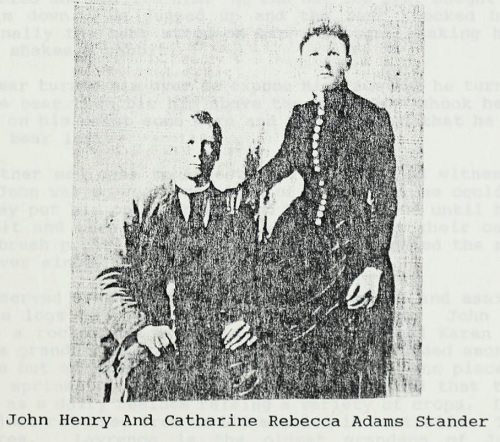
John Henry And Catharine Rebecca Adams Stander
He married Catharine (Kate) Rebecca Adams in 1889. She was born November 27, 1871,
in Richmond, Utah. After they were married he built a frame house, planted many
trees to provide a windbreak, and planted a large apple orchard. He was called
on an LDS Church (Mormon) mission to the southern states and left his wife and
three children for a time.
On the way back John was involved in a train
accident near Colorado. His passenger train hit a cattle train head-on. There
was a lot of commotion and excitement as it was midnight and the train was
burning. As he tried to exit the train he found that he had a broken leg. He
fell out of a window to escape the fire and remembers vividly the experience of
laying helpless on the ground listening to the cries of the hurt and burned
victims.
When help finally arrived they took hold of his hands and the
skin came off like gloves. The injured were taken by another train to a hospital
in Ogden. His shin bone below the knee was broken and a metal plate was attached
to the bone which remained with him the rest of his life.
He also had a
terrifying experience with a bear and her three cubs that left him with
permanent scars. In the spring some of his horses had wandered down the river
nearly eighty-five miles in their quest for good grass. They found a bear with
three cubs near their camp. Two of the men thought it would be fun to take the
cubs home and began to taunt the mother. It attacked. The two men were on good
horses and quickly outdistanced the bruin. John's horse stumbled and spilled
him. He ran but the bear caught him and slapped him down. He jumped up and the
bear knocked him down again. Finally the bear stood on him and began shaking him
just like a dog shakes a rabbit.
The bear turned him over to expose his
face but he turned over again. The bear then bit him above the waist and shook
her head. She chewed on his waist some more and then decided that he must be
dead. The bear left.
The other men came to investigate as they had
witnessed the mauling. John was so weak from lose of blood that he could hardly
stand. They put him on the horse and he would ride until he could not stand it
and then would walk for a ways. At their camp they put a sagebrush poultice on
his back. He has carried the scars on his back ever since.
John served
as a trustee on the school board and assisted in hauling the logs to build the
first school house. John and his sons built a rock house and this is where Roy
and Karen Stander Thompson, a granddaughter, live. The farm was divided among
three of the sons but as Karen said, "It is now back in one piece due to
Lawrence's sprinkling system." She also suggested that the farm had served as a
dairy besides raising a variety of crops. Lawrence and Delia just returned from
an LDS mission in Australia. They own eighty acres. Lawrence is the oldest
grandson of John and Catharine. Lawrence said he had raised potatoes for forty
years or more and also hay and grain.
Ralph is the only living child of
Stander's. He is ninety-four. He sold his farm to Lawrence.
John and
Catharine had eight children and she died December 15, 1928. He lived alone
until his palsy got too bad. He then made his home with his son, Ralph.
Ralph said, "Dad was a very hard working man and always honest in his dealing.
His life was spared more than once. He lived with us about six or seven years
and the last two years of his life he was bedridden and cared for by me and my
wife, Margaret. He died at our home June 30, 1951."
Source: Centennial Farm Families, published in 1991, pages 98-110, extracted 2021 Jun 17 by Norma Hass
Copyright © 1996- The USGenWeb® Project, IDGenWeb, Bingham County